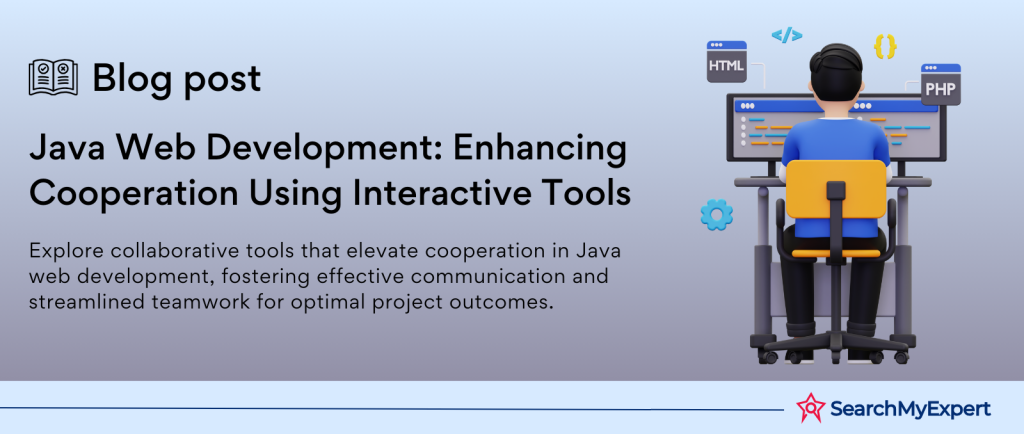Java Web Development Collaboration Tools
Java Web Development: The Cornerstone of Modern Web Solutions
In the digital era, Java stands tall as a pivotal force in web development. It’s a world where speed, efficiency, and precision are not just desired but demanded. Java, with its robust, versatile nature, powers numerous web applications, ranging from intricate enterprise solutions to dynamic websites.
Facing the Collaboration Conundrum
As Java web projects scale, the complexity skyrockets. Teams sprawl across geographies, time zones blur, and coordinating becomes a Herculean task. The challenges? Diverse. Think of miscommunication, inconsistent coding practices, and the ever-looming threat of missed deadlines.
Tools: The Game Changers
Enter the heroes: Collaboration tools. They’re not just tools; they’re catalysts for change. In the intricate dance of Java web development, these tools harmonize the steps, ensuring every developer is in sync, every code commit is tracked, and every project milestone is visible. They’re not just about working together; they’re about working smarter.
Types of Collaboration Tools
In the realm of Java web development, collaboration tools are the unsung heroes. They come in various forms, each with a unique role, collectively creating a symphony of efficiency. Let’s dive into their world, categorizing them based on their superpowers.
Code Version Control Tools: The Time Travelers
Examples:
Git, GitHub
Think of these as the historians of the coding world. They track every change, every line of code, like a meticulous diary. Lost in the maze of code? These tools are your compass, guiding you back through the history of your project, ensuring no effort is ever lost in time.
Project Management Tools: The Orchestra Conductors
Examples:
Jira, Trello
Here’s where chaos meets order. These tools are like conductors, orchestrating the myriad of tasks, deadlines, and milestones. They’re the planners, the organizers, turning a cacophony of tasks into a harmonious melody of structured progress.
Communication and Workflow Tools: The Connectors
Examples:
Slack, Asana
In the digital workspace, distance is irrelevant but communication is key. These tools bridge gaps, ensuring that no team member is an island. They’re the pulsating veins of the project, keeping the lifeblood of information and updates flowing seamlessly.
Testing and Deployment Tools: The Quality Guardians
Examples:
Jenkins, Bamboo
In the quest for perfection, these tools are indispensable. They’re the vigilant sentinels, ensuring every release is battle-tested, robust, and ready for the world. They automate the mundane, freeing developers to focus on innovation.
Real-time Collaboration Tools: The Instant Syncers
Examples: LiveShare, CodePen
Imagine a world where distance and time zones don’t hinder collaboration. These tools make that world a reality. They allow for instant, live collaboration, transforming solo coding sessions into dynamic, interactive workshops.
Top Tools for Different Collaboration Needs
In the bustling world of Java web development, collaboration tools are not one-size-fits-all. Let’s embark on a journey to discover the top tools, tailored to specific needs. Whether you’re a small startup or a large corporation, agile or traditional, there’s a tool that fits like a glove.
Code Version Control Tools
For Small Teams: GitLab
- Key Features: Integrated CI/CD, issue tracking.
- Why for Small Teams? It’s a one-stop shop, offering a comprehensive suite of tools within a single platform.
For Large Teams: GitHub Enterprise
- Key Features:
Advanced team management, large community. - Why for Large Teams? Scalable, robust, and offers extensive collaboration features.
Project Management Tools
Agile Teams: Jira
- Key Features:
Customizable scrum and kanban boards, agile reporting. - Why Agile? Perfectly aligns with agile principles and workflows.
Traditional Methodologies: Microsoft Project
- Key Features:
Gantt charts, project scheduling. - Why Traditional? Offers a structured approach, ideal for sequential project planning.
Communication and Workflow Tools
Open-source Projects: Mattermost
- Key Features: Open-source, self-hosted, high customization.
- Why Open-source? Aligns with the ethos and needs of open-source communities.
Proprietary Projects: Slack
- Key Features: Seamless integrations, robust API.
- Why Proprietary? High compatibility with other enterprise tools and secure communication.
Testing and Deployment Tools
For Continuous Integration: Jenkins
- Key Features:
Open-source, highly customizable with plugins. - Why for CI? It’s the go-to for CI, thanks to its versatility and strong community support.
For Automated Deployment: Bamboo
- Key Features:
Integration with Jira and Bitbucket, real-time visibility. - Why for Automated Deployment? Streamlines the deployment process, especially in larger, more complex environments.
Real-time Collaboration Tools
For Instant Code Sharing: LiveShare (Visual Studio Code)
- Key Features: Real-time code sharing and editing, integrated debugging.
- Why for Code Sharing? Facilitates instant collaboration, making pair programming and code review a breeze.
For Interactive Prototyping: CodePen
- Key Features: Live previews, community for feedback.
- Why for Prototyping? Ideal for quick, collaborative prototyping and sharing front-end development snippets.
Benefits of Using Collaboration Tools in Java Web Development
The adoption of collaboration tools in Java web development is akin to unlocking a treasure trove of efficiencies. Let’s illuminate the myriad benefits these tools bring to the table.
Improved Communication and Transparency
- The Breakdown:
No more communication breakdowns or siloed information. These tools act as a digital town square, where ideas, updates, and feedback converge in real time. - The Impact:
Enhanced team cohesion, fewer misunderstandings, and a culture of openness.
Streamlined Code Management and Version Control
- The Breakdown:
Imagine a world where code chaos is tamed. That’s what these tools do – track changes, merge code, and maintain order in the digital cosmos. - The Impact:
Fewer conflicts, quicker integration, and a well-documented code history.
Enhanced Visibility and Task Tracking
- The Breakdown: Every task, no matter how small, is visible. It’s like having a high-powered microscope that reveals the minute details of your project’s progress.
- The Impact:
Better project management, timely deliveries, and a clear roadmap for everyone.
Increased Efficiency and Productivity
- The Breakdown:
By automating mundane tasks, these tools free up valuable time, allowing developers to focus on what they do best – coding. - The Impact: Faster development cycles, more innovative solutions, and higher quality output.
Easier Knowledge Sharing and Mentorship
- The Breakdown:
Knowledge flows freely, unhindered by physical boundaries. These tools become a digital library, filled with insights, best practices, and lessons learned. - The Impact: A nurturing environment for learning, growth, and the seamless transfer of expertise.
Challenges and Considerations in Utilizing Collaboration Tools
While collaboration tools offer a plethora of benefits, navigating their use is not without challenges. Let’s explore the key considerations and potential hurdles to ensure a smooth sailing journey in the Java web development sea.
Security Concerns and Data Privacy
- The Reality: In a world where data is gold, these tools must be Fort Knox.
- The Consideration: Prioritize tools with robust security features and a clear data privacy policy to safeguard your digital treasures.
Tool Integration and Learning Curve
- The Reality:
Not all tools play nice with others. And sometimes, mastering them is like learning a new language. - The Consideration:
Seek tools that integrate seamlessly with your existing stack and offer intuitive usability or comprehensive training resources.
Cost and Pricing Models
- The Reality:
The best things in life are free, but the best tools? Not always. - The Consideration: Balance cost with functionality. Look for flexible pricing models that align with your team’s size and project scope.
Scalability and Future-proofed
- The Reality: Today’s perfect solution might be tomorrow’s bottleneck.
- The Consideration: Choose tools that can grow with you, adapting to future technological advancements and project complexities.
Case Studies: Collaboration Tools Transforming Java Web Development
Let’s explore real-life examples where Java web development teams leveraged collaboration tools to surmount challenges and achieve notable successes. These stories offer practical insights and showcase the tangible benefits these tools bring.
Startup Success with Agile Tools
- Company:
Tech Innovators Inc., a dynamic software startup. - Challenge: Rapidly evolving projects with a team spread across three continents.
- Solution:
Adopted Jira for agile project management, Git for efficient version control, and Slack for seamless communication. - Result:
Project delivery time reduced by 35%. The agile framework provided by Jira, coupled with Git’s robust version control and Slack’s real-time communication, enhanced team coordination and agility.
Global Corporation’s Project Revolution
- Company:
GlobalTech Solutions, a leading multinational corporation. - Challenge: Managing complex, large-scale projects across multiple international offices.
- Solution: Implemented Microsoft Project for detailed project scheduling, GitHub Enterprise for centralized code management, and Jenkins for automated continuous integration.
- Result: Noticed a 20% increase in project efficiency and a significant reduction in cross-departmental miscommunications, leading to streamlined global collaboration and on-time project deliveries.
Open-Source Project’s Community Empowerment
- Company:
OpenSourceDev, an open-source platform. - Challenge:
Coordinating contributions from a global, voluntary developer base. - Solution: Choose GitLab for comprehensive project management, Mattermost for community-driven communication, and CodePen for real-time coding collaboration.
- Result:
Saw a 50% increase in active contributors and a substantial rise in code quality. These tools fostered a collaborative, inclusive community environment, propelling the project’s growth.
The Future of Java Web Development with Collaboration Tools
A Symphony of Synergy
Collaboration tools in Java web development are not just tools; they are the conduits of innovation, efficiency, and success. We’ve journeyed through their types, benefits, challenges, and real-life triumphs. They’re the unsung heroes, turning individual notes into a harmonious symphony.
Emerging Trends: Gazing into the Crystal Ball
The future of collaborative development is vibrant and dynamic. We’re seeing AI integration for smarter assistance, cloud-based platforms for unparalleled accessibility, and increasingly intuitive interfaces that promise even more seamless interactions. The horizon gleams with the promise of more integrated, intelligent, and immersive collaborative environments.
Choose Your Arsenal Wisely
The landscape is vast, and the choices are many. But the right tool is the one that resonates with your team’s rhythm. Small or large, agile or traditional, open-source or proprietary – there’s a tool out there that fits your unique melody. Explore, experiment, and embrace the tools that will elevate your Java web development journey to new heights.
Embrace the future, where collaboration is not just a necessity but an art. And remember, in this digital orchestra, every developer is a maestro with the right tools in hand.
Conclusion
In the fast-paced world of Java web development, collaboration tools are indispensable. They streamline processes, enhance communication, and foster innovation. From small startups to global enterprises, these tools adapt to various needs, offering tailored solutions for every team. As we look ahead, emerging trends like AI and cloud computing are set to revolutionize these platforms further, promising even greater efficiency and connectivity. It’s crucial for developers and teams to explore and embrace these tools, finding the perfect fit to elevate their projects. The future of Java web development is collaborative, and with the right tools, the possibilities are limitless.
Partner with expert Java Development Service Agencies for robust applications.
Table of Contents
Toggle






